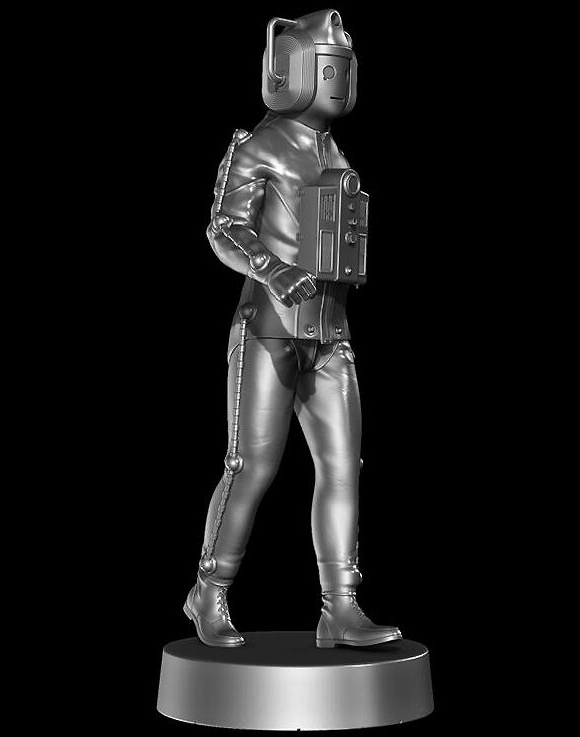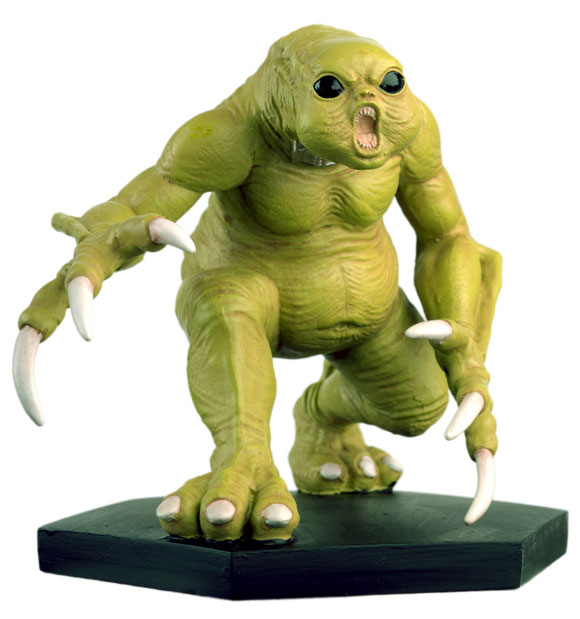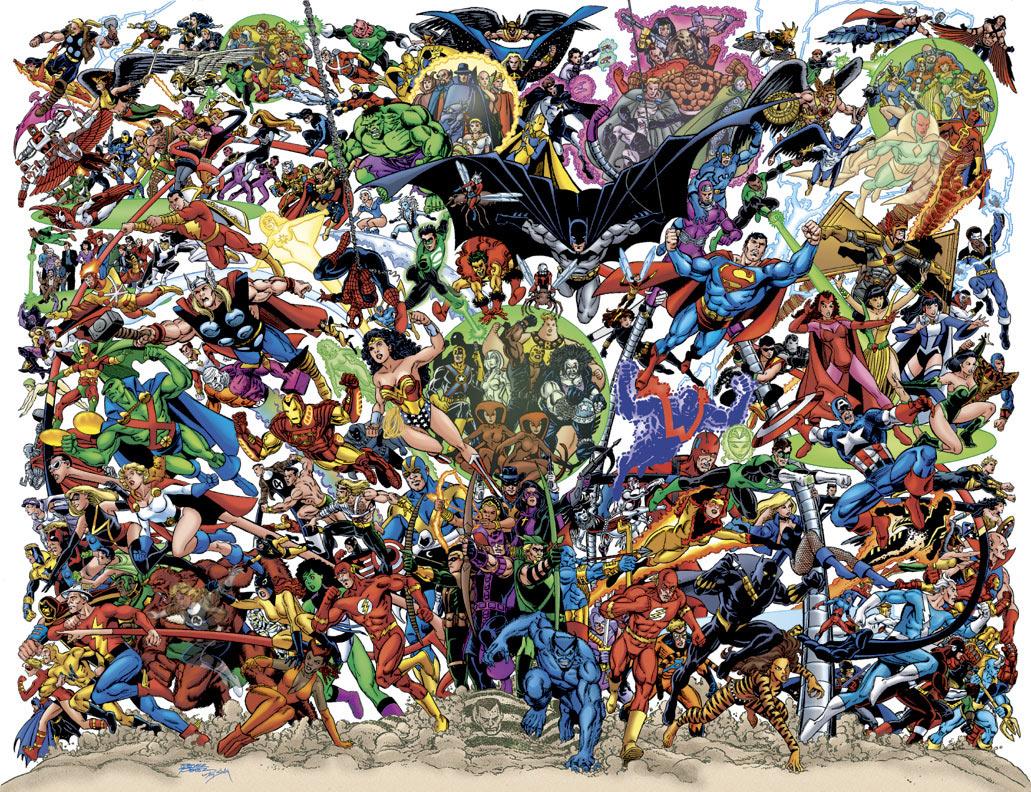I was expecting a delivery, and if it was what I suspected I'd actually been expecting this delivery for months. I felt the twinge of excitement as the post van rolled up outside, I was at the door before the postman had even knocked, but when I saw the box my spirits sank somewhat. This couldn't be it. It was far too big, unreasonably big. I had no idea what it could actually be otherwise, but I knew it couldn't be what I was so eagerly awaiting. Upon opening the top, my spirits rose once more as two figurines rested on yet another box inside. I removed the forms of Omega and a Cyberman from the top, encased in moulded plastic like Han Solo in carbonite, and pried the inner box from it's larger brother.
I almost sliced my finger open getting into it, but upon peeling back the cardboard flaps Angels began to sing and somewhere a tinny voice demanded extermination!
Inside, in more pieces than he should have been (but nothing a quick ring of super-glue couldn't fix) lay the Emperor Dalek. The single most ambitious figure I've ever seen Eaglemoss produce. For those who don't know, Eaglemoss are a publishing company that have been producing partwork magazines (fortnightly magazines that build up, issue by issue, into a larger whole) for longer than I can remember. I was rummaging in my wardrobe a few months back, and found a few issues of Spinechiller magazine, a collection of horror stories that came with pop up cardboard monsters, and was surprised to see their logo on the front. In recent years they've been involved with a number of licenses from popular fantasy and science fiction franchises including Harry Potter, Star Trek, Lord of the Rings and a number of comic book themed projects for DC and Marvel. Late last year they released their latest venture, The Doctor Who Figurine Collection and I love it.
Or at least, I've come to love it. My excitement for this collection has been a slow burning thing, that only really sparked off a few months ago. I've been with this collection since day one, and for years it's been something that I've dreamed the company would do, and yet as the figurines rolled in I was finding that I wasn't as excited as I thought I'd be. I'd take the figures out of the box, admire the craftsmanship, and flick through the magazine but I wasn't eagerly awaiting the arrival of each one like I had with the DC collection in the past. It wasn't until I began to look for previews of future figurines that a realisation struck me...

All the Cybermen figurines we've seen are almost in the exact same pose. From Invasion, right through to Nightmare in Silver they have this determined, unstoppable, marching gait that wheedled it's way into my imagination and threw up vivid images of an entire shelf of Cybermen lurching forward, blank faced and gleaming silver, in an unstoppable march. It was a powerful image, and I realised that it was the first thought I'd had towards the logistics of displaying this collection.
 |
| Image from http://merchandise.thedoctorwhosite.co.uk/ |
The Time Lords? Grouped around the TARDIS! Easy!
And when I saw the scale of the Emperor Dalek I knew exactly where my Dalek display was headed too.
It was all falling wonderfully into place. A shelf of Cybermen, accompanied by an army of Daleks. That is no exaggeration, we're only fifteen issues in and as you can already see I have four recruits to my legion of pepper pot Nazis so far, with many more soon to come! With ideas for displays now buzzing in my brain, I eagerly awaited the delivery of each issue and excitedly tore through the magazines. I'd found what I loved about this collection, what was going to define it, and I was extremely happy. Although I can imagine that many of you out there are puzzled right now. Unable to understand how I can get so excited over little lumps of resin shaped into characters from one of my favourite TV shows. Well, the short answer is that it's a mostly solid product that comes with an informative magazine and I'm a massive fan. Fans are irrational and do strange things, it's why we draw their descriptor from the word fanatic.
If you want the long answer, then I'm afraid we need to go a little more in-depth and step back in time!
 You see, I've dabbled in a couple of lines from Eaglemoss in my time. I have a couple of Hobbit figures here, a handful of Batmobiles there and even a shelf of Marvel figurines proudly on display. But my true love was the DC Figurine Collection. A series of lead figures based on the DC comics universe. If you pushed me to proclaim my allegiance to one of the big comics companies, I'd pick DC every time. You can roll out the old 'But Marvel's characters are more human and interesting than DC's!' argument all you like, and when it comes to the big draws you may well be right. But DC always had the best, obscure characters. The New Gods, the Doom Patrol, the Legion of Superheroes, Flash's Rogues, I love them all and the idea of having the entire DC Universe on my shelf, at an affordable price point? That was like a dream come true.
You see, I've dabbled in a couple of lines from Eaglemoss in my time. I have a couple of Hobbit figures here, a handful of Batmobiles there and even a shelf of Marvel figurines proudly on display. But my true love was the DC Figurine Collection. A series of lead figures based on the DC comics universe. If you pushed me to proclaim my allegiance to one of the big comics companies, I'd pick DC every time. You can roll out the old 'But Marvel's characters are more human and interesting than DC's!' argument all you like, and when it comes to the big draws you may well be right. But DC always had the best, obscure characters. The New Gods, the Doom Patrol, the Legion of Superheroes, Flash's Rogues, I love them all and the idea of having the entire DC Universe on my shelf, at an affordable price point? That was like a dream come true.
The character you're seeing to your left right now is Ambush Bug. Ambush Bug is, for better or worse, my favourite superhero. He's fairly obscure, but I always believed he had enough of a cult following to gain a place in the collection. So I campaigned and I made impassioned pleas and I may, just may, have made a few sneaky (read: very overt) suggestions to then editor and now very good friend Sven Wilson to include him. Eventually it happened, and I can't help but take a measure of pride in the finished product. It's absurd, I know. I didn't sculpt him, I didn't paint him, but I did input a few design ideas and I think that if I hadn't been out there, shouting into the darkness, making the case for this cult hero, this figurine wouldn't exist today.
And this is exactly what I loved about the DC Collection. It truly was a representation of the entire universe, in miniature, and the doors were wide open to anyone. No character too new, no character too obscure, the big guns would happily rub shoulders with the little guys in a way that no other collection of the same quality was managing. And as a fan who loved the lesser known characters as much as the characters everyone loves, this was important to me. It's why I was excited in the first place, and I truly believe that the DC Collection lived up to this ideal right up until it's all too premature end. An end I'm still in two minds about. On the on hand the new costume designs from the New 52 were making the collection an inconsistent hodge-podge, but on the other hand for the first time in the history of the collection both Wildstorm and Vertigo were wide open, and with most of the big guns down, the list of characters to choose from was more exciting than ever.
The excitement I feel for the Doctor Who collection is entirely different, though. I think the reason I wasn't initially as involved in the collection was because I don't really have much investment in what characters come next. Even the most banal of characters or monsters usually have interesting designs. The Vashta Nerada spacesuit is on it's way soon, a monster that I never felt had all that much impact on the show and is really just the animated remains of an archaeologist controlled by dark bacteria. There's also the Siltheen, which I think are some of the worst alien concepts to crawl from the Russell T. Davies era but I'll be damned if they both don't look fantastic!
 |
| Image from http://merchandise.thedoctorwhosite.co.uk/ |
The only thing I'd love is for the editors to relax their iron focus on Time Lords and monsters and let the companions get some love too, but beyond that I probably wouldn't be able to give you a top ten list of characters I want for this collection like I could routinely rattle off for the DC line. No, the excitement lies in seeing the history of the show come to life on my shelf. When I went to the Doctor Who Exhibition in London, they had these marvellous displays that would depict Daleks, Sontarans, Ice Warriors and Cybermen through the ages. All standing side by side, showing a direct comparison through the, then, almost fifty years of the show. When I had my epiphany about the Cybermen, it brought into focus that I could have something very much like this in miniature on my shelf. A time line of the various designs throughout the show's history, and all I'd have to do to see it is tilt my head up from my desk. As a fan, it's a truly intoxicating idea. And no, I don't care if you judge me for it.
 Of course, it also helps that despite a few quality control and customer service fumbles, Eaglemoss collections are usually quality products. The magazine is a thing of beauty, that you can learn all sorts of interesting tid-bits from and I'm pretty sure the editors behind the collection have some form of insanity. Not only did they produce a glossy covered small book for the TARDIS magazine, but the model that needed a box big enough for me to wear to get to my door safely? Is the FREE GIFT FOR SUBSCRIBERS. I can't even imagine the logistics it took to make and deliver that thing to so many people, with minimal breakages, and the idea that they're giving it away for free is just beyond the pale. I remember the free subscriber gift for the DC Collection (a much more modest Batman statue) eventually came up for sale in limited numbers at Forbidden Planet. It's going to be interesting, then, to see what price they actually pin on this if something similar ever happens.
Of course, it also helps that despite a few quality control and customer service fumbles, Eaglemoss collections are usually quality products. The magazine is a thing of beauty, that you can learn all sorts of interesting tid-bits from and I'm pretty sure the editors behind the collection have some form of insanity. Not only did they produce a glossy covered small book for the TARDIS magazine, but the model that needed a box big enough for me to wear to get to my door safely? Is the FREE GIFT FOR SUBSCRIBERS. I can't even imagine the logistics it took to make and deliver that thing to so many people, with minimal breakages, and the idea that they're giving it away for free is just beyond the pale. I remember the free subscriber gift for the DC Collection (a much more modest Batman statue) eventually came up for sale in limited numbers at Forbidden Planet. It's going to be interesting, then, to see what price they actually pin on this if something similar ever happens. Long may this kind of insanity, and indeed the collection, continue though! For more information on the Who collection, check out their Facebook page. It's surprisingly useful for news, answering queries and just a little bit of Who related fun. Also be sure to check out Doctor Who Merchandise for news and information, as well as my old stomping ground the Superhero Figurine Forum for almost all things Eaglemoss. For my part though, I have a giant model to admire and magazines to read!

















